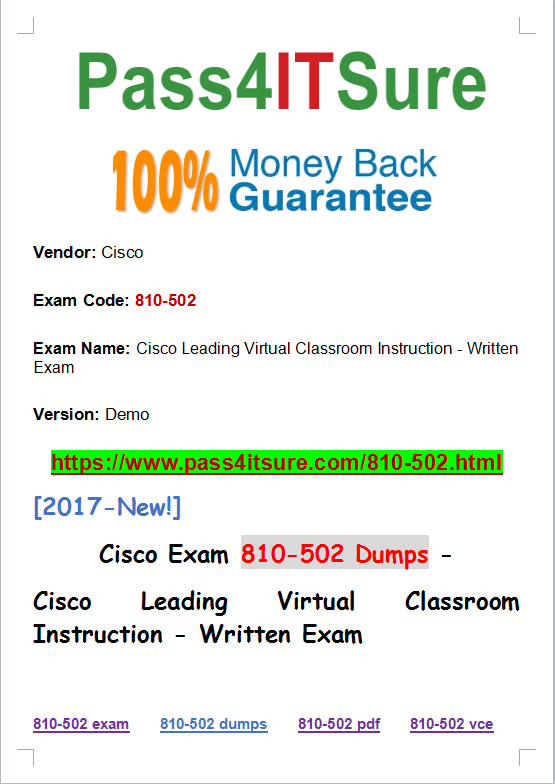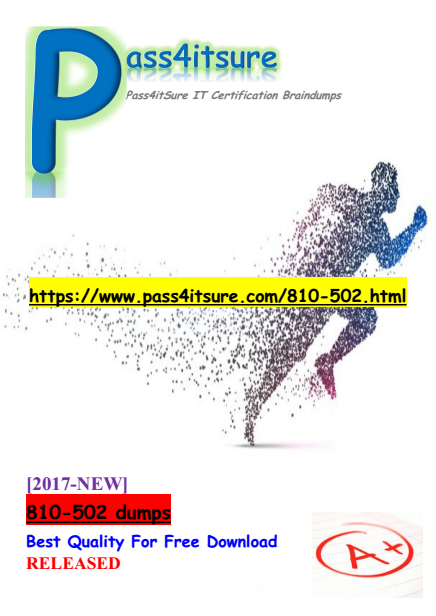How does Pass4itsure Cisco 810-502 dumps exam answers work? The Cisco Leading Virtual Classroom Instruction – Written Exam (810-502) exam is a computer-based,multiple-choice assessment in pass4itsure that is associated with the Cisco certification. Most important Cisco 810-502 dumps exam Cisco Leading Virtual Classroom Instruction Written exam with 100% pass rate video study. “Cisco Leading Virtual Classroom Instruction – Written Exam” is the exam name of Pass4itsure Cisco 810-502 dumps test which designed to help candidates prepare for and pass the Cisco 810-502 exam. The computer-based, multiple-choice exam tests the candidate’s knowledge of how to prepare and manage a virtual classroom environment and use collaboration tools to maximize student participation and comprehension. Candidates can prepare for the https://www.pass4itsure.com/810-502.html dumps exam by taking the Cisco WebEx Leading Virtual Classroom Instruction course.
[100% Valid Cisco 810-502 Dumps Questions From Google Drive]: https://drive.google.com/open?id=0BwxjZr-ZDwwWUlpfYUVGTkJBVDg
[100% Valid Cisco 300-135 Dumps Questions From Google Drive]: https://drive.google.com/open?id=0BwxjZr-ZDwwWVjNzVmpXTDBzU00

Pass4itsure Free Cisco 810-502 Dumps Exam Questions and Answers:
QUESTION 29
In the Fibre Channel protocol, what are functions of the FC-1 layer?
A. Encoding and decoding
B. Routing and flow control
C. Interface mapping and flow control
D. Transmission of raw bits and encoding
810-502 exam Correct Answer: A
Explanation
Explanation/Reference:
Explanation:
FC-1 Layer: It defines how data is encoded prior to transmission and decoded upon receipt. At the transmitter node, an 8-bit character is encoded into a 10-bit transmission character. This character is then transmitted to the receiver node. At the receiver node, the 10-bit character is passed to the FC-1 layer, which decodes the 10-bit character into the original 8-bit character. FC links with speed 10 Gbps and above use 64-bit to 66-bit encoding algorithm. This layer also defines the transmission words such as FC frame delimiters, which identify the start and end of a frame and primitive signals that indicate events at a transmitting port. In addition to these, the FC-1 layer performs link initialization and error recovery.
QUESTION 30
What is a security implementation in NAS environments?
A. Kerberos
B. Port binding
C. S_ID Lockdown
D. FC-SP
Correct Answer: A
Explanation
Explanation/Reference:
Explanation:
Security Implementation in NAS
NAS is open to multiple exploits, including viruses, worms, unauthorized access, snooping, and data tampering. Various security mechanisms are implemented in NAS to secure data and the storage networking infrastructure. Permissions and ACLs form the first level of protection to NAS resources by restricting accessibility and sharing. These permissions are deployed over and above the default behaviors and attributes associated with files and folders. In addition, various other authentication and authorization mechanisms, such as Kerberos and directory services, are implemented to verify the identity of network users and define their privileges. Similarly, firewalls protect the storage infrastructure from unauthorized access and malicious attacks.
QUESTION 31
In an FC SAN environment, what is a benefit of zoning?
A. Restricts RSCN traffic
B. Isolates fabric services
C. Enables online volume expansion
D. Provides non-disruptive data migration
810-502 dumps Correct Answer: A
Explanation
Explanation/Reference:
Explanation:
Zoning
Zoning is an FC switch function that enables node ports within the fabric to be logically segmented into groups and communicate with each other within the group. Whenever a change takes place in the name server database, the fabric controller sends a Registered State Change Notification (RSCN) to all the nodes impacted by the change. If zoning is not configured, the fabric controller sends an RSCN to all the nodes in the fabric. Involving the nodes that are not impacted by the change results in increased fabric-management traffic. For a large fabric, the amount of FC traffic generated due to this process can be significant and might impact the host-to-storage data traffic. Zoning helps to limit the number of RSCNs in a fabric. In the presence of zoning, a fabric sends the RSCN to only those nodes in a zone where the change has occurred.
QUESTION 32
What is the RAID 5 write penalty for random, small write I/Os?
A. 1
B. 2
C. 4
D. 6
Correct Answer: C
Explanation
Explanation/Reference:
Explanation:
QUESTION 33
Which EMC block-level storage virtualization product enables hosts from two different data centers to access a single copy of data?
A. VPLEX
B. VMAX
C. VNX
D. Vblock
810-502 pdf Correct Answer: A
Explanation
Explanation/Reference:
Explanation:
EMC VPLEX
EMC VPLEX is the next-generation solution for block-level virtualization and data mobility both within and across datacenters. The VPLEX appliance resides between the servers and heterogeneous storage devices. It forms a pool of distributed block storage resources and enables creating virtual storage volumes from the pool. These virtual volumes are then allocated to the servers. The virtual-to-physical storage mapping remains hidden to the servers. VPLEX provides nondisruptive data mobility among physical storage devices to balance the application workload and to enable both local and remote data access. The mapping of virtual volumes to physical volumes can be changed dynamically by the administrator. VPLEX uses a unique clustering architecture and distributed cache coherency that enable multiple hosts located across two locations to access a single copy of data. VPLEX also provides the capability to mirror data of a virtual volume both within and across locations. This enables hosts at different data centers to access cache-coherent copies of the same virtual volume. To avoid application downtime due to outage at a data center, the workload can be moved quickly to another data center. Applications continue accessing the same virtual volume and remain uninterrupted by the data mobility. The VPLEX family consists of three products: VPLEX Local, VPLEX Metro, and VPLEX Geo. EMC VPLEX Local delivers local federation, which provides simplified management and nondisruptive data mobility across heterogeneous arrays within a data center. EMC VPLEX Metro delivers distributed federation, which provides data access and mobility between two VPEX clusters within synchronous distances that support round-trip latency up to 5 ms. EMC VPLEX Geo delivers data access and mobility between two VPLEX clusters within asynchronous distances (that support round-trip latency up to 50 ms).
QUESTION 34
Which EMC product enables VNX array-based remote replication from a primary volume to a secondary volume residing on a different VNX storage system?
A. MirrorView
B. SnapView
C. RepliStor
D. SRDF
Correct Answer: A
Explanation
Explanation/Reference:
Explanation:
EMC MirrorView
The MirrorView software enables EMC VNX storage arraybased remote replication. It replicates the contents of a primary volume to a secondary volume that resides on a different VNX storage system. The MirrorView family consists of MirrorView/Synchronous (MirrorView/S) and MirrorView/Asynchronous (MirrorView/A) solutions. MirrorView/S is a synchronous product that mirrors data between local and remote storage systems. MirrorView/A is an asynchronous product that offers extended distance replication based on periodic incremental update model. It periodically updates the remote copy of the data with all the changes that occurred on the primary copy since the last update.
QUESTION 35
A customer has a requirement to perform a backup each night. However, the customer has a limited amount of time for backups to run on week nights, Monday through Friday evenings. Which backup granularity type is recommended to meet the backup window for those nights?
A. Incremental
B. Cumulative
C. Full
D. Differential
810-502 vce Correct Answer: A
Explanation
Explanation/Reference:
Explanation:
Backup Granularity
Backup granularity depends on business needs and the required RTO/RPO. Based on the granularity, backups can be categorized as full, incremental, and cumulative (or differential). Most organizations use a combination of these three backup types to meet their backup and recovery requirements. Figure on the slide depicts the different backup granularity levels. Full backup is a backup of the complete data on the production volumes. A full backup copy is created by copying the data in the production volumes to a backup storage device. It provides a faster recovery but requires more storage space and also takes more time to back up. Incremental backup copies the data that has changed since the last full or incremental backup, whichever has occurred more recently. This is much faster than a full backup (because the volume of data backed up is restricted to the changed data only) but takes longer to restore . Cumulative backup copies the data that has changed since the last full backup. This method takes longer than an incremental backup but is faster to restore. Another way to implement full backup is synthetic (or constructed) backup. This method is used when the production volume resources cannot be exclusively reserved for a backup process for extended periods to perform a full backup. It is usually created from the most recent full backup and all the incremental backups performed after that full backup. This backup is called synthetic because the backup is not created directly from production data. A synthetic full backup enables a full backup copy to be created offline without disrupting the I/O operation on the production volume. This also frees up network resources from the backup process, making them available for other production uses.
QUESTION 36
What is a characteristic of a scale-out NAS?
A. File system grows dynamically as nodes are added in the cluster
B. Up to four file systems can be created across the cluster
C. Distinct file systems are created on each node in the cluster
D. Different file systems can be mixed on each node in a single cluster
Correct Answer: A
Explanation
Explanation/Reference:
Explanation:
NAS Implementation – Scale-out NAS
The scale-out NAS implementation pools multiple nodes together in a cluster. A node may consist of either the NAS head or storage or both. The cluster performs the NAS operation as a single entity. A scale-out NAS provides the capability to scale its resources by simply adding nodes to a clustered NAS architecture. The cluster works as a single NAS device and is managed centrally. Nodes can be added to the cluster, when more performance or more capacity is needed, without causing any downtime. Scale-out NAS provides the flexibility to use many nodes of moderate performance and availability characteristics to produce a total system that has better aggregate performance and availability. It also provides ease of use,
low cost, and theoretically unlimited scalability. Scale-out NAS creates a single file system that runs on all nodes in the cluster. All information is shared among nodes, so the entire file system is accessible by clients connecting to any node in the cluster. Scale-out NAS stripes data across all nodes in a cluster along with mirror or parity protection. As data is sent from clients to the cluster, the data is divided and allocated to different nodes in parallel. When a client sends a request to read a file, the scale-out NAS retrieves the appropriate blocks from multiple nodes, recombines the blocks into a file, and presents the file to the client. As nodes are added, the file system grows dynamically and data is evenly distributed to every node. Each node added to the cluster increases the aggregate storage, memory, CPU, and network capacity. Hence, cluster performance also increases.

“Cisco Leading Virtual Classroom Instruction – Written Exam”, also known as 810-502 exam, is a Cisco certification which covers all the knowledge points of the real Cisco exam. Pass4itsure Cisco 810-502 dumps exam questions answers are updated (456 Q&As) are verified by experts. The associated certifications of 810-502 dumps is Cisco. The https://www.pass4itsure.com/810-502.html dumps Leading Virtual Classroom Instruction written exam is required for Cisco WebEx Virtual Classroom Instruction Specialist certification.